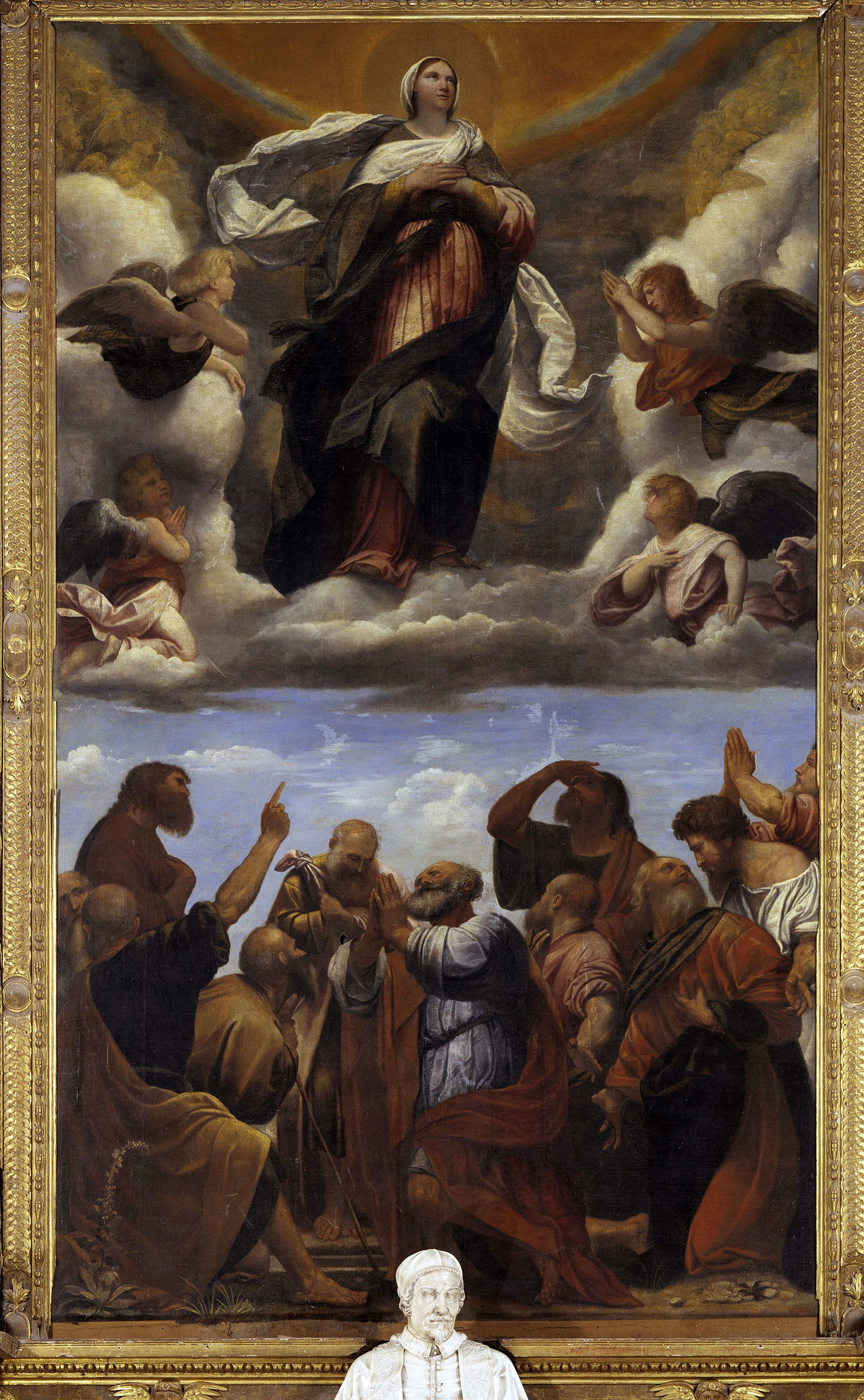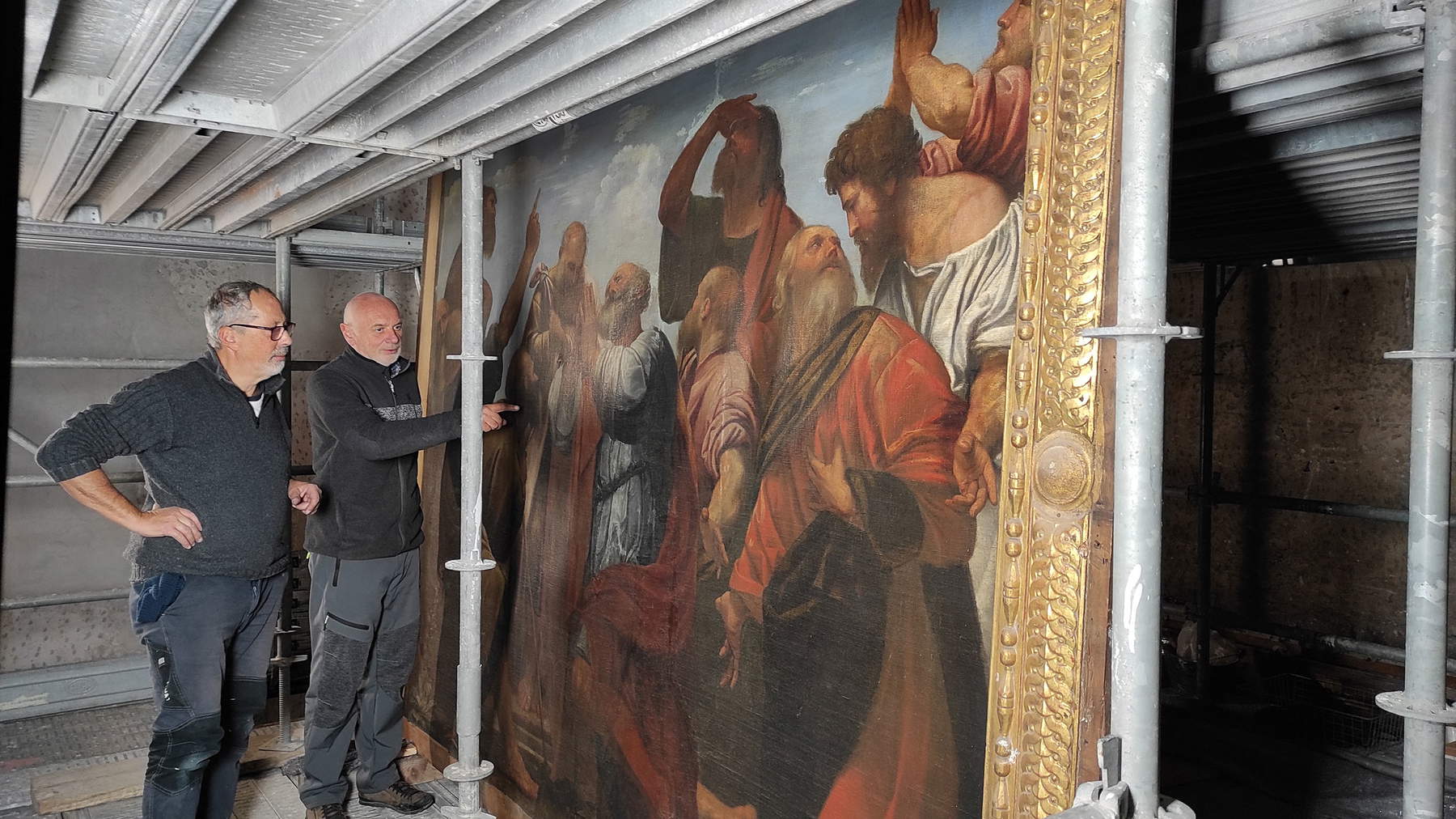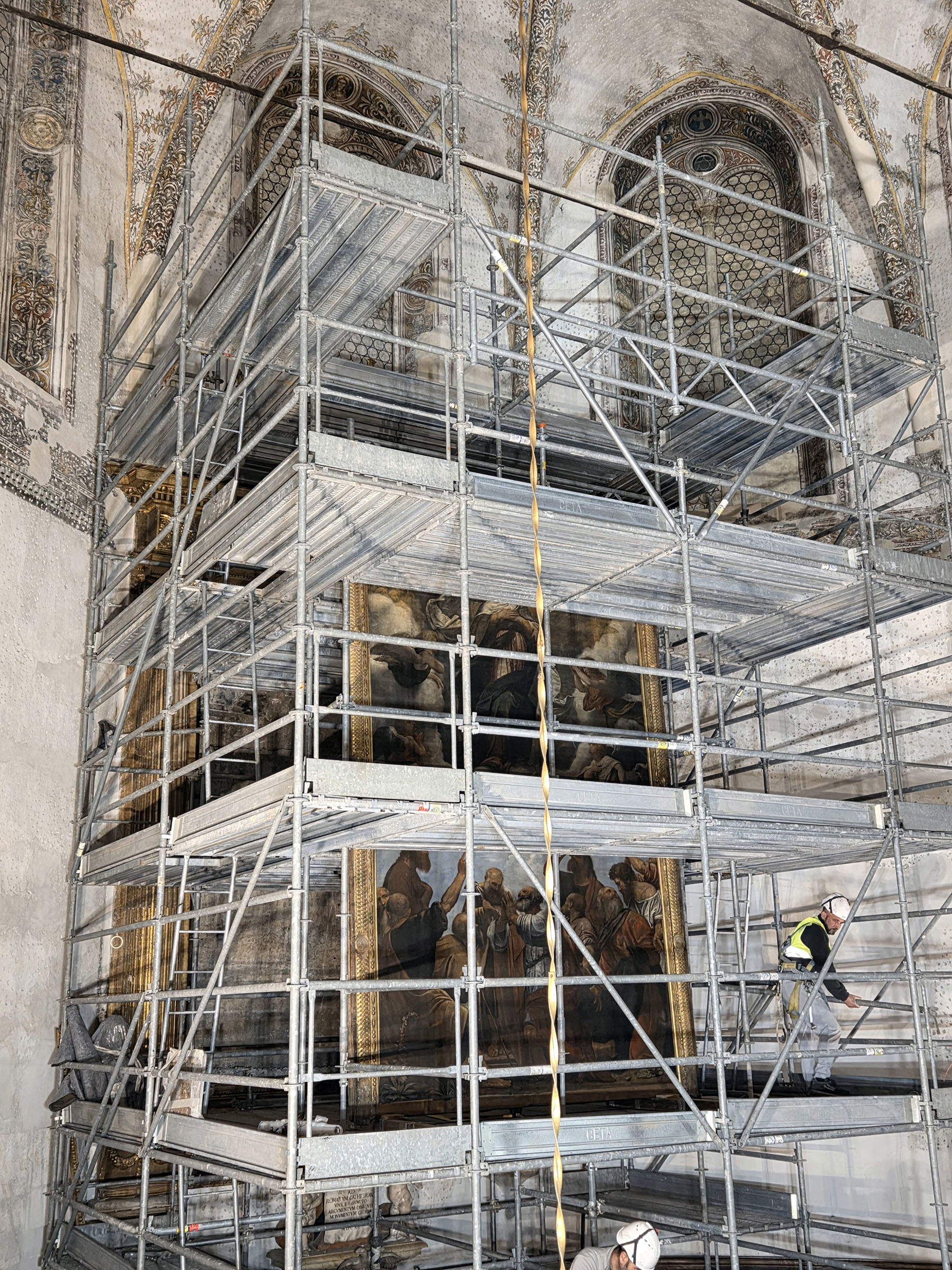On Monday, November 24, 2025, thestart of the restoration of the large altarpiece depicting theAssumption of the Virgin by Alessandro Bonvicino, known as il Moretto (Brescia, 1492/1495 - 1554), a masterpiece created between 1524 and 1526 and placed for five centuries on the high altar of Brescia’s Duomo Vecchio. The intervention, which coincides with the 500th anniversary of the work’s execution, represents one of the most significant conservation operations scheduled in the city in recent years and involves institutions, private entities and specialists united in a project intended to fully restore legibility and stability to one of the greatest examples of the Brescian master’s production.
The restoration has been promoted and supported by Ca’ del Bosco, a leading Franciacorta winery, and the Venetian Heritage Foundation, entities long committed to the protection of Italian artistic heritage, with the patronage of the Diocese of Brescia and the Cathedral Parish. The scientific and organizational coordination is entrusted to Davide Dotti, while the execution of the work has been assigned to Antonio Zaccaria’s restoration laboratory. Supervision is by Silvia Massari and Andrea Quecchia of the Brescia Superintendency, who will closely follow all phases of the intervention to ensure compliance with conservation criteria and full consistency with the material history of the work.


The complexity of the project is also linked to the exceptional size of the altarpiece, which measures 472 centimeters in height by 310 in width and is placed at a height of 4.5 meters inside a monumental gilded and carved wooden altarpiece, which is also to be restored. To avoid risks related to moving the huge canvas and historical frame, it was decided to carry out the intervention directly on site, transforming the altar area into a real open laboratory, a solution that allows to protect the work from thermo-hygrometric variations and at the same time to keep intact the relationship between the altarpiece and its liturgical and architectural context.
Moretto’s Assumption presents a complex narrative structure, articulated on two superimposed planes separated by a dense blanket of clouds. The upper part is dominated by the monumental and solemn figure of the Virgin, portrayed as she is welcomed into heaven by the angelic hosts that accompany her ascending movement. The lower register, on the other hand, is occupied by the group of apostles, caught in different attitudes expressing astonishment, bewilderment and a rich and dynamic gestural expressiveness, elements that make clear their surprise before the empty tomb and the miraculous event they are witnessing. The work, among the Brescian master’s most famous, encapsulates the full extent of his artistic maturity and a theological and compositional approach that makes it one of the high points of the Lombard Renaissance.
The restoration work, which will be completed during 2026, will address a twofold front: on the one hand the structural problems of the canvas and support, and on the other hand the aesthetic recovery, necessary to restore the work’s original luminosity and brilliance, dulled by time and surface deposits. The entire operation is accompanied by a program of non-invasive diagnostic investigations carried out by Vincenzo Gheroldi, whose task is to document the state of conservation of the work and to investigate the painter’s execution technique beyond the limits of the visible. The analyses will provide fundamental data to calibrate each phase of the restoration, determine the nature of the alterations and choose the most suitable materials to ensure a respectful and lasting intervention.
One of the peculiarities of the project is the desire to transform the construction site into a moment of participation and dissemination. For this reason, a calendar of visits will be prepared that will allow the public to closely observe the different stages of the work. The “Moretto worksite,” set up inside the Old Cathedral, will offer the opportunity to learn about contemporary restoration techniques and to understand the complexity of the operations necessary to safeguard a work of such proportions and historical-artistic value. This is an approach that aims to bring citizens closer to conservation activities, making visible a process generally carried out far from the eyes of the public.
The initiative takes on even greater significance in the context of the five-hundredth anniversary celebration of the altarpiece, an anniversary that provides an opportunity to reflect on Moretto’s role in Brescian and Italian art history. The Assumption represents not only a masterpiece destined for devotion and liturgy, but also a work that synthesizes an artistic season characterized by great attention to naturalism, chromatic refinement and the monumentality of the figures, elements that made Moretto one of the protagonists of the Renaissance in northern Italy.







“Ca’ del Bosco’s connection with the world of art and sculpture is well known by now,” says Maurizio Zanella, founder and president of Ca’ del Bosco. "This is the first time that we are dedicated to ancient art, to contributing to the restoration of a work of deep symbolic value for the city of Brescia. I am also pleased to continue the collaboration with Venetian Heritage beyond the Ca’ del Bosco Sculpture Prize, now in its second edition. The work that the Foundation and its director Toto Bergamo Rossi are conducting on Venetian artistic and cultural heritage is driven by the same motivations that guide Ca’ del Bosco’s patronage efforts: a Renaissance that builds the culture of the future through the avant-garde insights of the new generations that are called upon in this project. Venetian Heritage’s motto is Restoring the past, building the future, a concept that is not very different from the balance between tradition and innovation that has always guided the rebirth of our wine culture."
“It is an honor for me and for the Foundation I direct.” says Francesco “Toto” Bergamo Rossi, director of Venetian Heritage, “to enter into a partnership with an Italian excellence like Ca’ del Bosco. Since 1999 Venetian Heritage has been promoting Venetian culture through a vast campaign of restoration work carried out in Venice, but also in the territories that were formerly part of the Serenissima Republic. Brescia was an integral part of the Venetian dominions from 1426 until the Napoleonic invasion in 1797. The altarpiece in the Duomo Vecchio clearly testifies how the Venetian painting of the great Titian influenced the young Alessandro Bonvicino known as Moretto.”
“Not only from an artistic point of view, but also from a spiritual and religious one, this restoration gives relevance and visibility to the history of our city,” recalls Monsignor Gianluca Gerbino, parish priest of the Cathedral. “Theological and religious meanings help everyone discover art as an expression of the feelings and faith not only of the faithful, but also of the artist himself. This has allowed, in the succession of history, to open and appreciate the contents of faith, read and explained in the liturgy, but also made plastic by painting. Moreover, this painting by Moretto, so valuable and precious, is being returned even closer and more appreciable to each of us thanks to the recovery that will be carried out in these months. Thanks from me to all those who wanted, not without difficulty, to realize this work.”
“”It is a great honor,“ emphasizes Davide Dotti, ”to coordinate on a scientific and organizational level an event of such high artistic and cultural importance as the restoration of one of the most important works of Moretto’s early maturity, to be counted among the protagonists of Italian Renaissance painting. The altarpiece with the Assumption of the Virgin is not only a masterpiece of art history that enjoyed wide critical acclaim over the centuries, but it is also a symbol for all Brescians, lay and believing, preserved in one of the most iconic places in the city."
 |
| Brescia, start of restoration of Moretto's Assumption in the Duomo Vecchio |
Warning: the translation into English of the original Italian article was created using automatic tools. We undertake to review all articles, but we do not guarantee the total absence of inaccuracies in the translation due to the program. You can find the original by clicking on the ITA button. If you find any mistake,please contact us.